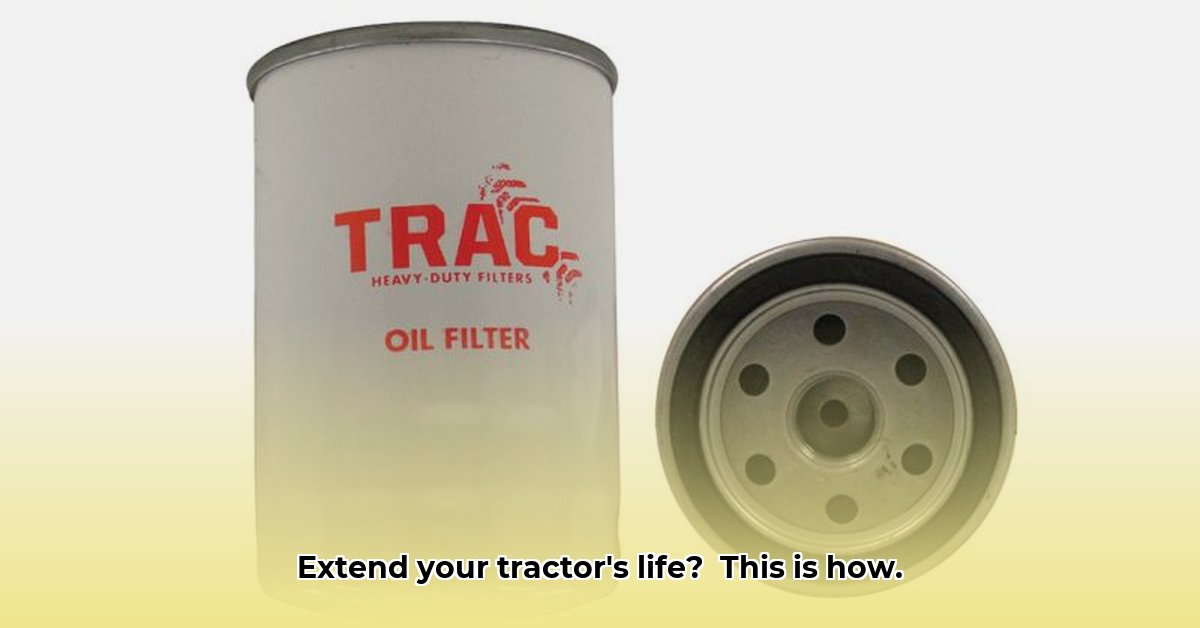
Tractor Oil Filters: Your Guide to Longer Engine Life
Your tractor is a vital asset, demanding regular maintenance to ensure peak performance and longevity. While many focus on fuel and major repairs, a frequently overlooked component crucial for engine health is the oil filter. This comprehensive guide covers everything from choosing the right filter to replacement techniques and responsible disposal, empowering you to keep your tractor running smoothly for years to come. We'll cover both spin-on and cartridge filters, offering clear instructions for all skill levels. For cross-referencing filter types, check out this helpful resource: Branson Tractor Oil Filters.
Understanding Tractor Oil Filters: The Engine's Silent Protector
Engine oil is your tractor's lifeblood, lubricating moving parts and preventing wear. However, over time, this oil accumulates contaminants—dirt, metal particles, and combustion byproducts. The oil filter acts as a vital safeguard, trapping these harmful impurities before they can damage your engine. Neglecting oil filter maintenance is like letting your engine run on abrasive grit, causing premature wear and costly repairs.
Two primary types of tractor oil filters exist: spin-on and cartridge. Spin-on filters are cylindrical units that screw directly onto the engine block, making replacement relatively straightforward. Cartridge filters, on the other hand, reside within a larger canister; replacement involves accessing the canister, swapping the filter element, and reassembling. The correct type depends entirely on your tractor's make and model; always consult your owner's manual.
Choosing the Right Oil Filter: OEM vs. Aftermarket
When replacing your oil filter, you have two main choices: Original Equipment Manufacturer (OEM) filters, produced by your tractor's manufacturer, or aftermarket alternatives. OEM filters guarantee a perfect fit and are specifically designed for your engine's needs, ensuring optimal performance and reliability, although they usually cost more. Aftermarket filters offer a more budget-friendly option, but careful selection is crucial. Many reputable aftermarket brands produce high-quality filters, but compatibility with your specific tractor model is paramount. Using an incompatible filter can cause leaks, reduced filtration, and potential engine damage. Always consult your owner’s manual or parts supplier for compatibility information.
Recommended Replacement Intervals: A Personalized Approach
Determining the optimal oil filter replacement interval involves several factors. Manufacturer recommendations, typically expressed in operating hours, serve as a starting point. However, these are guidelines; the actual interval depends on:
- Operating conditions: Intensive use (plowing tough fields, heavy hauling) necessitates more frequent changes.
- Environmental conditions: Dusty or muddy environments increase contaminant levels, demanding more frequent replacements.
- Oil type: Higher-quality oils might slightly extend filter lifespan.
The following table offers general guidance. Always prioritize your tractor's owner's manual for the most accurate recommendations.
| Operating Conditions | Recommended Filter Change Interval (Hours) |
|---|---|
| Light use | 75-100 |
| Moderate use | 50-75 |
| Heavy use, dusty conditions | 25-50 |
Remember, consistent adherence to a maintenance schedule, informed by your specific operating conditions, significantly impacts engine longevity. A proactive approach saves money in the long run.
Step-by-Step Oil Filter Replacement: A Practical Guide
Replacing a tractor oil filter is manageable, but safety and precision are vital. Always let the engine cool completely to prevent burns. Wear gloves and eye protection.
Spin-on Filter Replacement:
- Position a drain pan beneath the filter.
- Use a filter wrench to loosen the old filter (some oil spillage is expected).
- Unscrew the old filter by hand.
- Lightly lubricate the new filter's rubber gasket with clean engine oil.
- Screw on the new filter by hand, tightening it to the manufacturer's specifications (consult your manual).
- Dispose of the used filter properly (see below).
- Double-check for leaks after starting the engine.
Cartridge Filter Replacement:
Cartridge filter replacement is more complex and varies greatly depending on the tractor model. Your owner's manual provides model-specific instructions. Generally, it involves accessing the filter housing, removing the old cartridge, installing a new one, and then reassembling the housing, carefully ensuring all seals are properly seated to prevent leaks.
Troubleshooting Common Issues: Addressing Potential Problems
Despite careful execution, issues might arise during filter replacement.
- Filter removal difficulty: Use the correct wrench. If it remains stuck, seek professional help; forcing it risks damage.
- Oil leaks: Recheck filter tightness and examine the gasket for damage.
- Housing access problems: Consult your owner's manual; if problems persist, seek assistance from a mechanic.
Proper Disposal of Used Filters and Oil: Environmental Responsibility
Used oil and filters are hazardous waste and must be disposed of responsibly. Never pour used oil or discard filters improperly—this is both illegal and harmful to the environment. Locate your local designated collection centers for used oil and filters; recycling is crucial. Check with your local authorities or waste management company for specific guidelines.
Conclusion: A Small Investment, Large Returns
Regular oil filter changes are a small but vital part of tractor maintenance. They protect your engine, extending its lifespan and saving you from costly repairs. Consistent adherence to a manufacturer-recommended schedule, adjusted for operational needs, is paramount for maximizing your tractor's performance and longevity. Always consult your owner’s manual; it is your invaluable guide to ensuring your tractor's continued success.
Resources
- Your Tractor Manufacturer's Website: Consult your tractor's owner's manual for specific recommendations.
- EPA Guidelines on Used Oil Recycling: Find information on responsible disposal practices.
- Local Recycling Centers: Locate your area's used oil and filter recycling facilities.